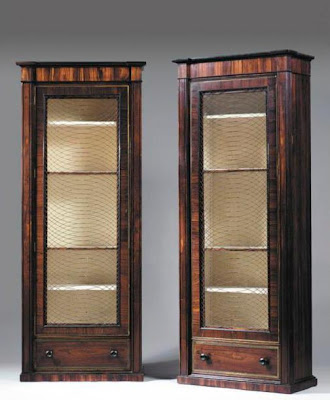A PAIR OF REGENCY BRASS-INLAID LABURNUM AND EBONY BOOKCASE CABINETS ATTRIBUTED TO GEORGE BULLOCK
Height 7ft. 11in.; width 38in.; depth 18in
Each with grille-inset door and later internal hinged glazed
door opening to a white-painted interior with adjustable shelves
$ 125,000.
George Bullock was a major and influential early nineteenth
century cabinet maker, and although he only had a short life he had a
spectacular career. He was a highly talented individual who gained a reputation
firstly as an artist of note and later as a cabinet-maker. He was renowned for
the speed that his furniture was produced and the quality achieved, especially
in refined and elegant inlay work. These are both tributes to his dynamism and
entrepreneurial skills.
Bullock was based in both London and Liverpool. He moved to
Liverpool first as his brother, William, was established on Church Street as a
museum promoter. It was here that he met William Stoakes for whom he went into
business with as a cabinet maker and general furnisher. This was the first time
that he started designing and making furniture.
In 1810 his brother moved to London to create his famous
museum in the Egyptian Hall in Piccadilly. George quickly followed and put the
contents of his premises up for sale. Once in London he opened in 1813
'Bullock, George, Upholsterers' on the same site as his brother museum before
moving to the Mona Marble Works on Oxford Street with his new partner Charles
Fraser.
Whilst practicing as an artist, Bullock, sculpted in both
marble and wax. The use of marble continued in his furniture designs. He also
incorporated gilt metal ornamentation and ebony marquetry within the pieces.
Bullock's portfolio included a wide range of exotic woods which, together with
his inimitable style, produced a particularly recognizable
"signature" to his work. The originality and advanced character of
his designs, some in the French style, are amply demonstrated by the fact that
G.J. Marant's work in precisely the same style - but produced twenty-five years
later - looked equally up to date for the 1840's.



Comments
Post a Comment